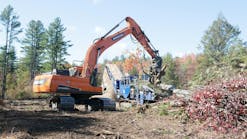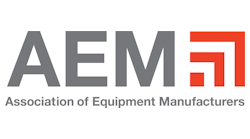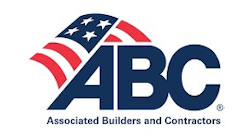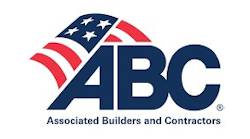To put equipment theft into easily comprehensible terms, Paul McMahon, senior director of corporate and marketing communications for the National Crime Information Center (NCIC), breaks it down as roughly 200 pieces of equipment stolen every week. And it’s a growing problem; McMahon reveals that insurance company theft reports have increased 10%–20% every year since 1996.
Stacy Kaufman, director of sales and marketing for National Equipment Register Inc. (NER), says that’s just a rough estimate: “It’s hard to know; many thefts aren’t even reported.” Co-worker Adam Gurzynski estimates losses totaling $300 million to $1 billion annually. “The question is that big gap. Details are sporadic, and thefts are randomly recorded.” He explains that algorithms in place for autos detect errors in vehicle identification numbers, but the lack of a similar system for construction equipment has hampered recovery.
Who, What, Where, When, Why, and How
A survey by the LoJack Corp. indicates that 71% of equipment owners experienced theft in the last year and that 35% of the lost equipment cost $50,000 or more per item. However, Gene Zolezzi, national director of construction in the risk control department of CNA Insurance Companies, says it’s not always the high-value equipment that gets snatched. “What gets stolen is whatever equipment is in demand in a particular area, or what kind of equipment a theft ring has a request for.”
As a general rule of thumb, Ken Poppe, product marketing manager for new technology at John Deere, applies a “theft attractiveness measure” to judge the likelihood of theft. The measure includes such assessments as the equipment’s resale value, the ease of loading and transporting it, and whether or not it has any distinguishing marks or paint schemes. “Compact machines—like skid-steers, agricultural tractors, and backhoes—are in demand because they’re easy to resell,” he says.
Gurzynski agrees that smaller, more mobile equipment is the first to go. “Skid-steers are number one. They bring $30,000 to $60,000; they’re easy to roll onto a trailer; they can be towed behind a pickup; and they can be easily hidden in a garage.” Backhoes are also popular, he adds. The bottom line is thieves will steal anything, he exclaims in frustration. “They take parts and attachments, too, but we deal predominantly with self-propelled vehicles.”
The LoJack study (its sixth annual [ITALIC]Construction Equipment Theft Study[ITALIC]) analyzing stolen vehicle recovery reports for the 2006 calendar year indicates that in addition to size and mobility, age is a selection factor: The newer the equipment, the higher the resale value. Eighty-two percent of stolen equipment is less than five years old. All factors taken into consideration, the equipment most frequently stolen ranked:
- backhoe loaders, skip loaders, and wheel loaders;
- skid-steer loaders;
- generators, air compressors, and welders;
- forklifts and scissorlifts;
- light towers;
- light utility and work trucks; and
- trailers.
McMahon adds dump trucks—which he says are often stolen for their aluminum beds—to the list, along with excavators, flatbeds, track loaders, and front loaders.
Theft occurs everywhere, but according to the same LoJack study it happens most frequently in California, Florida, Texas, Arizona, Georgia, Nevada, New Jersey, Maryland, Illinois, and Louisiana.
The NCIC ranks heavy equipment theft differently, with Texas leading California, Florida, North Carolina, Georgia, South Carolina, Tennessee, Ohio, Oklahoma, and Missouri. By city, Houston tops the list, followed by Phoenix, AZ; Las Vegas, NV; Dallas, TX; Miami, FL; Riverside, CA; Oklahoma City, OK; Sacramento, CA; and Tampa, FL.
Typically, equipment theft is highest in states undergoing construction projects fueled by rapid growth. Louisiana joined the list, thanks to increased construction post–Hurricane Katrina. On the other hand, Zolezzi says, CNA gets the most claims from Texas. “It’s a huge state with lots of open space.” However, he admits, theft is “also easy in busy areas like downtown Chicago.” Thieves “look the part” and act with authority, stealing equipment in plain sight.
No matter the state, McMahon estimates that three-quarters (the LoJack study estimates 79%) of all theft occurs on a job site. “Typically, it’s not secured at night or on the weekend, and nobody is paying attention.” Remote, unsecured job sites are at greatest risk. Gurzynski concurs, adding that larger sites are even harder to secure and that weekends—especially long holiday weekends—are prime targets for thieves, with 37% of thefts reported on Monday mornings. “Long periods of time off the job site, such as during a holiday, encourage theft,” Zolezzi emphasizes. “Thieves work 365 days a year.”
According to Tom McLaughlin, communications manager for Case Construction Equipment Inc., the location varies from year to year and from season to season. While job sites are “definitely a high target for equipment theft, dealers are getting hit more and more.” He has also noticed that thefts spike during spring and again in the fall.
While it may be logical that theft increases during the busy construction season, the specific time of day is perhaps a little surprising. Undoubtedly, a certain amount of clandestine under-cover-of-the-night theft takes place; but, increasingly, theft occurs in broad daylight right under the noses of construction companies. “We hear stories all the time,” Gurzynski begins. “People just hand over equipment to crooks who use fake receipts and wear hardhats. They say they’re there to pick up equipment for service, and the dealer just gives it to them!”
Some thieves pretend to represent an equipment rental company pulling machinery for another job or for service. Other thieves are company employees. “When employee theft is involved, the owner is usually unaware it has even occurred, so no one looks for missing equipment!” Gurzynski says, with a hint of amazement in his voice.
Oftentimes, large contractors have extensive fleets that are working on multiple job sites. If record keeping is lax, equipment can be difficult to track. “Some companies grow quickly and lose track of their fleets. Big companies have thousands of skid-steers,” Gurzynski calculates. “They may not know if one is missing.”
“It’s amazing that people don’t keep track of equipment,” Kaufman muses.
Although McMahon admits that employee theft is a big enough issue that LoJack is often asked to surreptitiously install its systems without employee knowledge, he still believes theft rings are a bigger concern. The number of professional theft rings rose in 2006, with law enforcement uncovering 14 different groups and chop shops. “They’re pros; they know what they’re doing, and they’re doing it in big numbers.” He recounts the story of a recovery made near Chicago in June 2007. An International truck was equipped with LoJack. Its signal led police to more than two dozen additional pieces of stolen equipment valued just under $1 million at a chop shop. “Sometimes thieves strip off parts—Honda parts are worth a lot. They may install different parts and resell them. It depends on the components.”
A lot of machinery is packed in shipping containers and put on freighters. “Over-the-border theft is a big issue,” McMahon surmises. Despite that, he estimates that 98% of stolen equipment never leaves its local area. In fact, most of the recovered equipment is discovered in a storage facility in the area or on another local job site.
Easy to Do, Hard to Detect
“Common keys” make it easy for thieves, McLaughlin believes. Coded entry isn’t always used because it slows down the work flow. It’s also a safety issue. Contractors want operators to have quick access to a machine in case of emergency. “They want to keep it simple,” Gurzynski explains, “so they use one key for everything.”
Also enabling thieves is the lack of security and protection devices and/or any other deterrent. LoJack’s study reveals that fewer than 12% of companies that experienced theft had security systems in place. Only 35% of companies put any kind of identifying mark on equipment.
Without sufficient site security to deter them, and without an organized, efficient recovery system, there’s little standing in the way for thieves who are enticed by the high demand and equally high resale value of heavy equipment. Because equipment is difficult to trace, the risk of being caught is low.
Construction equipment theft may not be a high-priority crime, Gurzynski speculates. “There’s very little diligence in the resale market. Little is done to verify stolen equipment.” However, he admonishes, it needs to be addressed because it affects everyone through higher prices and longer delays on road construction.
While contractors may agree that theft should be addressed, only a small percentage use theft deterrents or tracking devices, Zolezzi believes. “They think their equipment is too big to be stolen, that their security is sufficient, and that law enforcement will help.” He recognizes that law enforcement is aware of the problem and is working to decrease crime, acknowledging “they pull over anything suspicious.” However, police can do little about the problem without the proper tools.
One tool is NER’s database service, with 13 million records that trace the ownership history of construction equipment. Stolen equipment is often resold to unsuspecting contractors, McMahon says. There’s very little paper trail; it’s hard to follow. As Kaufman says, “There’s no DMV for construction equipment.” This may be the next-best thing.
Stories of customers looking for too-good-to-be-true deals frequently come to the attention of Case employees. “If customers don’t do any checks on the equipment, they can unknowingly purchase stolen equipment,” explains McLaughlin. “This makes it easier for thieves to off-load equipment.” He advises people who are purchasing used equipment to get the product identification number (PIN) and check with local law enforcement to see if there are any active thefts listed on it.
NER works closely with a network of 4,500 law enforcement officers to expedite vehicle recovery. An online automated search function is available to law enforcement 24 and seven, providing officers with proof of ownership to solve cases. “If the police have information,” Kaufman says, “they pursue investigations. They stop equipment and ask questions.”
That’s a big step, Gurzynski says. Since many states don’t require paperwork to be carried (unlike with autos), since most used equipment is sold with little more than a handshake and a bill of sale (requiring no title and no registration at a government agency), and since the location of serial numbers can be difficult to locate because they aren’t standardized, many officers have little basis for stopping anyone. NER’s online report sheet speeds up the recovery process, getting detailed information to police quickly.
Thwarting the Thieves
Nevertheless, the key remains to stop theft before it occurs. Job site security practices recommended by manufacturers such as Case and John Deere include the following tips.
- Record ID numbers for each piece of equipment. This can be complicated by the fact that the PIN, or serial number, is often located in different areas on different machines, even within the same brand, even though it is critical to recovery.
- Mark equipment with an owner-applied number (OAN).
- Keep accurate inventory records that include PIN, OAN, manufacturer, model number, year, and purchase date.
- Take color photos of the side of each machine. This could help with identification during a recovery investigation. Poppe advises companies to mark their equipment with a unique paint scheme, company name, or logo.
- Always park equipment in well-lit areas. Motion sensors can be valuable.
- Park in high-traffic areas.
- Add surveillance cameras for another layer of protection, eliminating the need for onsite security guards.
- Erect a fence constructed of see-through material so thieves can’t hide. A layer of barbed or razor wire can enforce a fence, too.
- Add other barriers, such as posts, berms, ditches, or low walls to prevent equipment from being driven or towed off.
- Interlock equipment when parking it—bucket-inside-bucket, for example, or by “trapping” attachments inside a circle of machinery.
- Advise nearby 24-hour businesses about equipment parked in the area and what times it should—and shouldn’t be— moved. Inform local law enforcement of the same information.
- Use theft-deterrent devices.
- Register with a national database service.
Zolezzi adds two more tips.
- Remove skid-steers from the job site.
- Take the keys from all equipment.
NER suggests making theft prevention policies part of the company business plan, networking with other contractors and organizations, assigning employee ID cards, logging in all visitors to the job site, stashing disposable cameras at job sites to record suspicious activity, offer safety incentives and recovery rewards, anchor equipment with a brightly colored chain or cable, maintain minimum fuel level on equipment in transport, park equipment in rows so that missing machinery is quickly obvious, and never give up hope.
These inexpensive ideas will slow a thief down. “The longer a thief is on a site, the more risk he takes,” Poppe explains. “He’s looking for an easy steal, so if you complicate things, he’s likely to move on.” Other ideas he offers include installing a battery disconnect switch behind a locked door. Primarily a maintenance tool, it also serves to discourage theft. So, too, does a spring-applied hydraulic release brake that can only be released when the engine is running.
Another level of theft deterrent involves adding a keyless start on skid-steers and other equipment. As Poppe points out, John Deere—and most manufacturers—use the same key for all their machines, making it easy for thieves who have experience in the construction industry. Zolezzi has seen sets of keys from all the major manufacturers for sale on eBay. A programmable code given to select employees can keep a thief from stealing machinery.
Electronic Assistance
A new tool to fight theft is John Deere’s new JD Link, which tracks location. The electronic add-on factory option can be retrofitted on existing machines with 12- or 24-volt systems—and “even pickups!” Poppe points out. Its “geo-fence” allows operators to set boundaries; an alert is issued if the vehicle moves beyond the physical boundary. Another feature is the curfew that allows the operator hours of operation to be set. If the machine is started outside those hours, an alert is generated. Those features can also reduce employee theft.
Similar features are available through aftermarket systems, such as Qualcomm Wireless Business Solutions’ GlobalTRACS equipment management system with GPS-based equipment for location and proactive theft prevention. Integrated into leading industry software programs, it decreases the risk of loss from theft and unauthorized use with such after-hours security features as a curfew fence that creates an electronic boundary with automatic alerts when machinery leaves its authorized area and an engine-start curfew that signals unauthorized usage.
“You can know where your equipment is at any given time, and if a curfew or virtual fence security breach happens, authorized personnel are notified immediately via text message, e-mail, cell phone, or pager,” explains Larry Cleary, vice president and general manager for the construction equipment group at Qualcomm. “No one has to wait and see that the machine is moved or missing to know there has been a security breach.” He calls it an obvious advantage over other products that offer only reactive theft tracking.
When a theft occurs, time is of the essence. Qualcomm’s geo-fence feature helped rescue a 30-ton Grove RT 530 E crane (cherry picker) belonging to Zachry Construction. Zachry’s equipment coordinator, Joe Serda, received an automatic alert in San Antonio notifying him that the crane had made an unauthorized move from an equipment storage yard in Houston. He contacted the equipment superintendent in Houston, John Froleich, who confirmed that the crane, a KW W900B hauling truck, and a Load King 40T lowboy trailer were missing. He immediately issued a wireless command to locate the unit, and once Froleich received the street location and geographical coordinates, he contacted police. The equipment was quickly retrieved with only minor cosmetic damage, thanks to the information from the GlobalTRACS system and the fast action of employees and authorities.
While the geo-fence is an effective theft deterrent, the curfew feature assists billing duties by removing any question of usage that could lead to dispute. Customer service is enhanced by reducing potential confrontation arising from disputed service, thanks to GPS, which provides the ability not only to locate equipment but also to know what it’s doing at any point in time.
Those features can also reduce employee theft. In addition, they benefit rental companies because the multifunction unit can also track billable hours per job site. “Rental companies charge by the hour,” Poppe explains. “They lose revenue if the machine is running beyond the rental agreement. With the geo-fence, the rent doesn’t stop.” Theft comes in many forms, he says, adding that it also eliminates human error.
“The industry changes fast; you have to come up with new ideas. It’s important to John Deere, and we’re working with customers to learn how to battle theft. As we put new stuff out, we help pull the numbers back down. Theft involves more than just the cost of the missing equipment; it includes the disruption of work. Using a system like JD Link to track the location of equipment can help with inventory control and insurance costs. Like in the automotive industry, you can expect newer machines to have deterrents.”
Unlike the auto industry, more of the deterrents on construction equipment are not easily detectable. Covert technology is a more expensive option, but one that’s very successful in recovery. McMahon considers it crucial to LoJack’s success. “Crooks know how to get around devices, but if there are no visible signs of one, they won’t know there’s anything to get around!”
Devices are randomly located at various sites on the equipment to avoid a predictable pattern that could be readily discerned by thieves. The device is activated when a police report is filed. It emits an inaudible radio frequency signal capable of penetrating buildings, shipping containers, and more. McMahon says police cruisers with tracking computers for vehicle-to-vehicle communication can listen for the signal; even helicopters can track it. “It’s proven technology for tracking valuable mobile assets.”
For 20 years LoJack has been providing what McMahon refers to as “an important layer of security” with its stolen-vehicle recovery system. The company that invented the stolen-vehicle recovery market is still going strong, with approximately 5 million units installed globally. Citing a success rate higher than 90%, McMahon humbly states, “Our success is due to the fact that we’re directly integrated with the police.”
Recovering From It All
Success isn’t easy to come by. According to statistics furnished by LoJack, 63% of theft victims never see their equipment again. Last year, however, the company recovered more than $18.6 million worth of stolen construction equipment, a figure that is up 18% from the previous year. Kaufman claims the overall recovery rate is a mere 10%, but notes that NER’s recovery rate has doubled each of the six years it’s been in business.
McLaughlin says Case has received more theft reports over the last several years but credits part of the increase to improved communication with dealers and insurance companies. Case works with law enforcement to assist with identifying stolen equipment, but the company also implemented its own theft-reporting procedure with all its dealers. When a customer reports a theft, information is relayed to the corporate security office, which blocks it in a warranty system so that it will alert other dealers if the stolen equipment turns up for service. It’s an effective procedure, because even when it is recovered, equipment is often damaged: 67% of recovered equipment was returned damaged.
“Sure, you have insurance for stolen equipment,” Zolezzi reasons, “but you also have a deductible that can be up to $10,000 per piece of equipment.” CNA has an alliance with LoJack: If a piece of machinery equipped with a LoJack device is not recovered, CNA waives the deductible.
An Ounce of Prevention
“Prevention is the key,” Zolezzi prophesies. “It’s a big problem in the industry and it hasn’t been adequately addressed.” Gurzynski sees awareness on the rise, and says that in this digital age, more can be done.
NER focuses on risk management education, teaching people in the industry some practical tips to prevent theft and to recover stolen equipment. Regional summits held at various locations around the country are free to all equipment owners, law enforcement, insurance reps, rental houses, and other vendors. The purpose is to network, learn, share information, and brainstorm new ideas. “We also give an award to an officer for assisting with recovery. It brings the community together,” Kaufman states.
Registration helps prove whose equipment is recovered. While Kaufman would prefer contractors to “register everything,” she recognizes that even with a $30 one-time registration fee, it’s not always feasible to put every piece of equipment into NER’s database. “It’s impossible to protect every piece of equipment.” She advises concentrating on protecting the equipment most frequently stolen, such as generators, which are popular because they’re small and versatile. “Typically, we suggest registering everything $5,000 and up.”
NER has been working with manufacturers, insurers, and big rental houses to register equipment. Soon, NER will also be available to everyone in the industry. “We’re just rolling out Iron Check for buyers to check the history of ownership of the equipment they’re buying in order to determine the legitimacy of the machine,” Gurzynski announces.
In addition to registering equipment, NER focuses on common-sense steps to asset management. “We try to convince them to keep good records—PINs, component part numbers …,” Gurzynski adds. Buckets and other attachments are difficult because there’s no serial number, but he notes that “there are ways to figure out whose machine it is, even if the numbers have been removed.” NER also trains law enforcement officials on where to look for PINs and decals.
Similarly, CNA’s 65 construction specialists visit customers to discuss protection. In addition to meeting with key clients individually, they offer training classes with open enrollment. “Classes book quickly,” reports Zolezzi.
Many in the industry are taking advantage of free education about theft prevention. As McMahon points out, the cost of theft encompasses far more than just the cost of machinery; it includes downtime and replacement costs. LoJack’s survey indicates that 67% of contractors who suffered equipment theft had to extend their time on construction projects due to loss of productivity, and 64% said equipment loss increased operating costs due to contract penalties and/or the need to add extra security.
The MSRP on a LoJack device is $795. Although it’s a one-time cost that is refunded if stolen equipment is not recovered within 30 days, McMahon acknowledges it’s cost-prohibitive for some. For those on a budget, he suggests using LoJack only on the equipment that’s at greatest risk. “Our biggest customers are rental companies, but this is an opportunity for small contractors too. Missing equipment has a greater effect on their business because their inventory is limited.”
For budget-minded contractors, one financial aspect of theft prevention to be considered is the fact that discounts are sometimes offered by insurance companies for the use of deterrents. In addition, NER offers discounts to various associations and organizations.
“Telematics provides companies with operational insight and a competitive advantage necessary to thrive in today’s challenging business environment,” Cleary believes. The ability to receive information needed to make crucial real-time decisions that can improve operational performance and positively affect the bottom line are some of the important advantages offered by equipment management systems.
With law enforcement, insurers, and even manufacturers now onboard, NER’s focus is on “the little guy,” Gurzynski says. “Fifty percent of loss is due to theft. It’s a no-brainer to register.” In the long run, he offers, it could save a lot of money.









